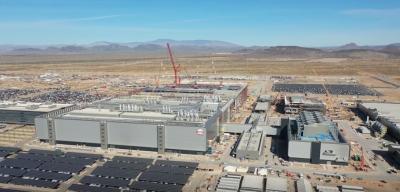Running through the southeastern United States is a vein of white clay suitable for human consumption, making paper, rubber and ceramics manufacturing and use for fracking. Ted Smith of Arcilla Mining is going after the clay in a big way.
Arcilla Mining & Land Co. has entered a third decade of mining kaolin clay, transporting it to processing plants up to a hundred mi. away and restoring the land to a productive condition. This major earthmoving activity is accomplished on the tracks and tires of more than a hundred pieces of heavy equipment.
Arcilla — Spanish for "clay" — is one of the bigger mining companies in the region, and three of Smith’s sons are following their father into the family business. Sons Kevin and Ashley are involved and the third son, Garrett will come aboard this summer after graduating from Georgia Southern University.
A Geology Heritage
Arcilla is a sprawling enterprise and has been in the geology business for quite a while. Smith’s father was a respected geologist in Georgia. After 15 years of engineering and survey work, Ted Smith decided to build a geology-oriented company that was partially supported by his father’s professional reputation for fairness and honesty.
Arcilla Mining & Land Co. was started in 1992 with some residential work, but was not the main aspect of the business.
"Back before the world fell apart in ’07 and ’08, we did some subdivisions, kind of a sideline," Smith said. "We will probably get back into residential land development when the economy recovers, as we continue to grow the company."
As a mining-focused firm, Arcilla is almost by definition a land company. The company owns or controls about 30,000 acres of mineral-rich land, and at any given time some 300 of those acres are being mined. Not all of the mining is done on Georgia soil, although the Peach State is where Arcilla got its start.
The success of the Georgia mining work led to expansion of the company 13 years ago into Alabama counties with kaolin deposits. Six years later, the company expanded to kaolin-rich areas of South Carolina. In 2005, Arcilla moved its crews and equipment into Arkansas. Bauxite is the mineral harvested from the earth there.
As owner and CEO of Arcilla, Smith manages mining operations across four states. The properties are continuously being opened up and closed down as the clay vein is systematically depleted, and the land restored to a natural and productive state. The company does every stage of the discovery, mining and reclamation process at each mine. According to Smith, that sort of all-inclusiveness sets them apart from others in the industry.
Growing Kaolin Demand
The kaolin clay has rather extensive utility in a wide range of manufacturing processes. The clay enhances the work of inks in slick-paper publishing and extends the coverage of paints of interior and exterior applications. It is a vital ingredient in rubber, plastic and fiberglass manufacturing as well as computer fabrication. It is even a pharmaceutical additive because it is ph neutral and a harmless additive to medicine.
The clay’s latest application is for an injected solution in a booming new industry — oil and natural gas drilling using hydraulic fracturing. Much of Arcilla-mined kaolin is used to that end.
The processed kaolin has been found to be a better “proppant” than the more commonly used sand. The regular grain configuration of kaolin ceramic is more effective in propping open the fractured shale rock so that oil and gas can flow into the collection pipes. The number one use of Arcilla’s raw kaolin clay is for processing by Carbo Ceramics into a proppant. Arcilla trucks carry tons of the clay each workday to three Carbo plants in Alabama and Georgia.
Bauxite has long been the principal source of aluminum ore, though the United States is not a major source of it. However, Arkansas does have an ample supply, including near the town of Bauxite.
Heavy Equipment
Arcilla has three equipment maintenance shops in McIntyre and Wrens, Ga., as well as Bauxite, Ark. The three tech facilities are key centers for Arcilla operations and maintain digging and hauling machinery at the several operating mines.
Arcilla’s 50 Mack trucks, both straight beds and tractor-trailers are constantly ferrying raw kaolin and bauxite to customers’ processing centers. To ensure they don’t stop rolling, the company’s truck maintenance shops operate two shifts a day, six days a week. The mechanics that maintain dirt-moving equipment and off-road vehicles work a single shift six days a week.
Smith estimates his inventory of equipment is approximately 126 machines — including 30 excavators, 18 dozers, 18 off-road trucks, 10 motorgraders, and 50 highway trucks.
Volvo is a principal brand of machinery found on Arcilla mining sites, with 40-ton (36 t) articulated trucks carting away overburden, and Volvo excavators and motorgraders scooping and scraping clay and soil. ASC Construction Equipment USA Inc. is the Volvo dealer that serves Arcilla, with southeast branches in Georgia, the Carolinas, and Tennessee.
The ASC-Arcilla business relationship goes back a decade. Charlie Roupe is the sales representative working closely with Smith and other Arcilla executives. In the last 18 months alone, the mining company has purchased seven Volvo 40-ton articulated trucks. Smith favors the trucks, he said, because the “get-up time” is good and they produce excellent fuel economy.
“ASC and Volvo Financial have been extremely supportive of our business,” said Smith, singling out Deric Cameron, business finance manager of Volvo.
Other brands Smith depends on include Caterpillar dozers, 50-ton (45.4 t) articulated trucks, excavators and graders and John Deere dozers and excavators.
The machinery is only as good as the operators of it Smith said and the company has managed to hold onto talented operators. In all, the company employs 120 people.
The Mining Process
Before the first dozer puts its blade to topsoil and begins to expose the kaolin underneath, Arcilla Land & Mining Co. is already several stages into the mining operation. It begins with testing of a property and follows with all the authorizing paperwork.
“We have the capacity to drill and test for a mineral deposit and to acquire the properties through lease or fee simple acquisition,” said Smith. “We do our own permits with the state. Then we have our own stripping crews, and load and haul the mineral ourselves. The final step is when we reclaim the property.”
It sounds like a neat and systematic procedure, but is made complex by the fact the company is continuously acquiring property and constantly drilling and testing. The front end as well as the end of the process is never static.
Excavation of a kaolin mine usually involves removal of trees and removal and segregation of topsoil for eventual replacement on the reclaimed property. Coordinated movement of equipment through the mined acreage also is required. Overburden — the material between the topsoil and the mined mineral — is systematically removed and transferred to the adjacent area most recently mined. There is constant shifting of overburden so that at any given moment only the area being actively mined is completely exposed.
Typically the kaolin lies about 65 ft. (19.8 m) below the surface. Approximately 170,000 cu. yds. (129,974 cu m) of material are removed to get to one acre of the white clay. The exposed vein of useable clay usually runs 20 ft. (6 m) thick. GPS technology is employed to guide the excavating machinery.
Eight crews are continuously digging their way through Arcilla holdings each year uncovering and removing some 3.5 million tons (3.17 million t) of kaolin and 300,000 tons (272,155 t) of bauxite.
Reclamation
Surface mining has gotten a bad reputation due to the ugly cavities, destruction of vegetation and threats to the local ecology. Yet according to Smith there is little local resistance to the mining activity — which happens to be the second largest industry in southern Georgia to timber production.
The economic impact of the mines may give pause to people alarmed by the process. The public acceptance could well be a sign of confidence. The industry — and certainly Arcilla — is conscientious about fully reclaiming property rather than leaving it in a wasted condition.
“I look at it this way,” said Smith. “God put a natural resource here for use of mankind. As a steward of the land, we try to do a good job of extracting this clay and putting the land back to a useable state for future generations.”
State EPA officials enforce Federal Environmental Protection Agency rules, but Arcilla is committed to the process regardless of mandates.
To that end, closed mining properties are filled and smoothed, with slopes not exceeding 3-to-1 steepness, and appropriate native vegetation replanted. The company partners with landowners to create ponds. The ph of the water is tested and treated so the water is neither acidic nor alkaline. The ponds are then stocked with fish. To date, Arcilla has created a dozen ponds and more are on the way.
Weather Challenges
Challenges face every industry and the challenge plaguing kaolin-mining companies in Georgia is water. Surface mining is vulnerable to inclement weather costing company’s money. This year, the central Georgia area has been drenched by 27 in. of rain, about 15 in. more than usual. Under ideal circumstances kaolin is about 20 percent water, not including runoff, so rain can be destructive.
With the influx of rain this year Georgia has seen the end of a three year drought, that mostly benefited kaolin production.
“To deal with the water we have about 20 pumps and generators dewatering the mines,” said Smith.
Smith has an entire crew dedicated solely to that task, running pumps 24 hours a day, seven days a week to stay ahead of the seeping and pooling ground water. The pumps range in size from 13 to 58 hp (9.6 to 43 kW).
“It keeps us on our toes,” said Smith.
Smith hopes that his sons will also be kept on their toes. When asked if he thinks there will be enough kaolin for his sons to continue to mine, Smith’s response is simple.
“We’ll be mining it 50 years from now, yes sir,”
Today's top stories















